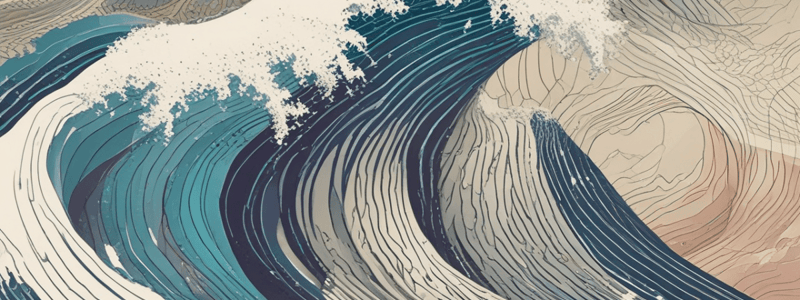Podcast
Questions and Answers
What is the term that refers to the movement of waves?
What is the term that refers to the movement of waves?
- Wave speed
- Wave propagation (correct)
- Wave amplitude
- Wave frequency
What is the unit of measurement for wave speed?
What is the unit of measurement for wave speed?
- Hertz (Hz)
- Kilograms per meter (kg/m)
- Meters per second (m/s) (correct)
- Joules per second (J/s)
Which of the following factors does NOT affect wave speed?
Which of the following factors does NOT affect wave speed?
- Density
- Tension
- Color (correct)
- Rigidity
What type of waves require a medium to propagate?
What type of waves require a medium to propagate?
What is the direction of vibration of particles in transverse waves?
What is the direction of vibration of particles in transverse waves?
What does frequency measure in a wave?
What does frequency measure in a wave?
What is the formula to calculate wave speed?
What is the formula to calculate wave speed?
How do higher temperatures affect the speed of sound?
How do higher temperatures affect the speed of sound?
What is the relationship between wavelength and frequency of a wave?
What is the relationship between wavelength and frequency of a wave?
What type of wave requires a medium to travel through?
What type of wave requires a medium to travel through?
What is the distance between one part of a wave and the next similar part called?
What is the distance between one part of a wave and the next similar part called?
What type of wave can pass through solids, liquids, and gases?
What type of wave can pass through solids, liquids, and gases?
What is the speed of sound dependent on?
What is the speed of sound dependent on?
What is the formula to find the speed of sound?
What is the formula to find the speed of sound?
How does the speed of sound change with an increase in temperature?
How does the speed of sound change with an increase in temperature?
What is a characteristic of electromagnetic radiation?
What is a characteristic of electromagnetic radiation?
Which type of electromagnetic radiation has the lowest frequency?
Which type of electromagnetic radiation has the lowest frequency?
Which of the following is NOT a harmful type of electromagnetic radiation?
Which of the following is NOT a harmful type of electromagnetic radiation?
What is the definition of the electromagnetic spectrum?
What is the definition of the electromagnetic spectrum?
Which of these applications is NOT associated with microwaves?
Which of these applications is NOT associated with microwaves?
Which type of electromagnetic radiation is used for medical imaging of bones and organs?
Which type of electromagnetic radiation is used for medical imaging of bones and organs?
What is the relationship between the angle of incidence and the angle of reflection for a wave hitting a surface?
What is the relationship between the angle of incidence and the angle of reflection for a wave hitting a surface?
What happens to the amplitude of an object when it is exposed to its resonant frequency?
What happens to the amplitude of an object when it is exposed to its resonant frequency?
Which of the following is a good example of an occurrence where resonance can be observed?
Which of the following is a good example of an occurrence where resonance can be observed?
What is the result of constructive interference in standing waves?
What is the result of constructive interference in standing waves?
What is an example of the Doppler effect in sound waves?
What is an example of the Doppler effect in sound waves?
What is the term used to describe the phenomenon where a sound source is traveling faster than the speed of sound?
What is the term used to describe the phenomenon where a sound source is traveling faster than the speed of sound?
What does Edwin Hubble's observation of the Doppler effect in light waves imply about the universe?
What does Edwin Hubble's observation of the Doppler effect in light waves imply about the universe?
What happens to the apparent frequency of waves when the distance between a wave source and an observer is increasing?
What happens to the apparent frequency of waves when the distance between a wave source and an observer is increasing?
What is the term used to describe the shift in frequency when a galaxy is moving away from an observer?
What is the term used to describe the shift in frequency when a galaxy is moving away from an observer?
What is the term used to describe the shift in frequency when a galaxy is moving towards an observer?
What is the term used to describe the shift in frequency when a galaxy is moving towards an observer?
What is not changed by the Doppler effect?
What is not changed by the Doppler effect?
What phenomenon occurs when a light wave's frequency matches the resonant frequency of an object?
What phenomenon occurs when a light wave's frequency matches the resonant frequency of an object?
In which circumstance does constructive interference occur?
In which circumstance does constructive interference occur?
What is the result when waves interfere destructively?
What is the result when waves interfere destructively?
What happens to a wave when it passes from a slower medium to a faster medium?
What happens to a wave when it passes from a slower medium to a faster medium?
What is the term for points along a standing wave that do not experience displacement?
What is the term for points along a standing wave that do not experience displacement?
What guides the bending of a wave at the interface of two different media?
What guides the bending of a wave at the interface of two different media?
Which statement regarding resonance is correct?
Which statement regarding resonance is correct?
What separates the different colors of light in a prism?
What separates the different colors of light in a prism?
Flashcards are hidden until you start studying
Study Notes
Wave Basics
- A wave is a vibration or disturbance that travels and carries energy.
- Wave propagation refers to the movement of waves, defined by frequency, amplitude, wavelength, and wave speed.
- Wave speed (v) is calculated using the formula: v = f × λ, where f is frequency (in Hz) and λ is wavelength (in meters).
- Factors affecting wave speed include tension, rigidity, density, and temperature of the medium.
Types of Waves
- Waves can be categorized based on the presence of a medium:
- Mechanical Waves: Require a medium (e.g., sound waves).
- Electromagnetic Waves: Do not require a medium (e.g., light).
- Waves are also classified by propagation direction:
- Transverse Waves: Particles vibrate perpendicular to wave direction (e.g., waves on a string).
- Longitudinal Waves: Particles vibrate parallel to wave direction (e.g., sound waves).
Wave Properties
- Frequency: Number of wave cycles per second.
- Wavelength: Distance between identical points on waves (e.g., crest to crest).
- Amplitude: Maximum displacement from the midline of a wave, not correlated with frequency.
- Wave speed is the product of wavelength and frequency; longer wavelengths correlate with lower frequencies.
Sound Waves
- Sound is a vibrational energy moving through a medium, creating compressions (high pressure) and rarefactions (low pressure).
- Speed of sound varies by medium, fastest in solids due to close molecular proximity, slower in liquids, and slowest in gases.
- Temperature affects sound speed; higher temperatures increase molecular energy, speeding up sound transmission.
Electromagnetic Radiation
- Electromagnetic waves propagate through space, carrying energy at the speed of light, consisting of electric and magnetic components.
- The electromagnetic spectrum includes:
- Radio Waves: Lowest frequency, used in communications.
- Microwaves: Used in cooking and communication technologies.
- Infrared Light: Used for heat and in remote sensing.
- Visible Light: Light detectable by the human eye.
- Ultraviolet Light: Can cause skin damage, higher frequency than visible light.
- X-rays: Used for medical imaging.
- Gamma Rays: Highest frequency, used in cancer treatment.
Reflection and Refraction
- Reflection: Change in direction of waves upon hitting a surface, described by the law of reflection (angle of incidence equals angle of reflection).
- Refraction: Bending of waves when passing from one medium to another, explained by Snell's Law, relating angles of incidence and refraction to indices of refraction.
Wave Interference
- Constructive Interference: Occurs when waves combine to produce a wave with larger amplitude.
- Destructive Interference: Occurs when one wave's crest cancels another's trough, resulting in reduced amplitude.
- Standing Waves: Formed from the interference of two waves with the same frequency moving in opposite directions.
Doppler Effect
- The Doppler effect describes the change in frequency of waves as the source and observer move relative to each other.
- An ambulance siren demonstrates the effect, producing a higher pitch when approaching and a lower pitch when receding.
- In light, redshift and blueshift indicate galaxies moving away or toward an observer, respectively, providing evidence for the expansion of the universe.
Studying That Suits You
Use AI to generate personalized quizzes and flashcards to suit your learning preferences.




